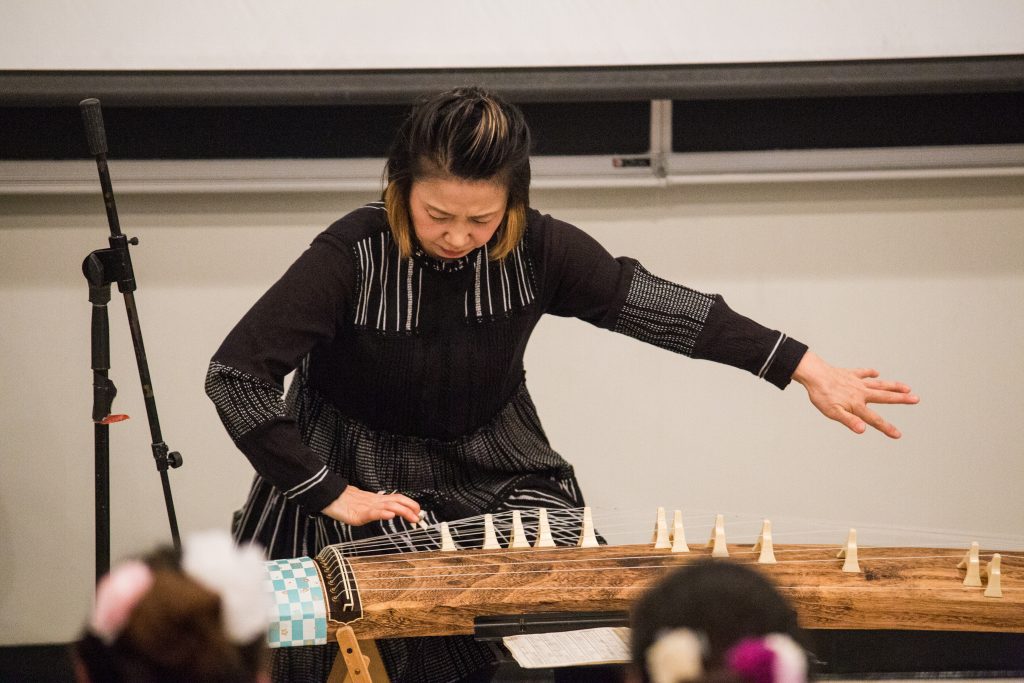After performing her first song, traveling musician Masayo Ishigure asked a room packed with students, professors and local community members how many of them had heard of the koto, a nearly six-foot-long traditional Japanese instrument equipped with 13 strings. The room was split, with roughly half of the attendees being familiar with it. Ishigure was visibly excited.
“Last week I performed in Detroit and I asked the same question: zero,” Ishigure said.
Ishigure is working to change this unfamiliarity through her performances, most recently with a show at Binghamton University on Friday, March 8. She performed a five-song set that included both contemporary and traditional pieces in order to show the versatility of the two instruments, including a cover of “Amazing Grace.”
Ishigure has an impressive background in music. She began to play both the koto and the shamisen, a three-stringed instrument resembling a guitar, at the age of five while living in Japan. She received a degree in traditional Japanese music from Takasaki Junior Arts College and moved to New York City shortly after. She now teaches koto and shamisen at Wesleyan University and Columbia University, offering private lessons as well.
Despite these successes, Ishigure talked about some of the difficulties she has faced in her career. Between songs, she mentioned that she has had surgery three times on her left hand due to the immense pressure necessary to push down the strings of the koto. She also discussed the difficulty of traveling with such a large instrument, which requires a case and shoulder strap.
“I used to be much, much taller,” she joked.
Ishigure performed both the koto and vocal parts. She was assisted on the song “Aki Sayaka” by Kayo Yoshida, a BU lecturer of Asian and Asian American Studies, who played the shamisen. Yoshida has been playing for five years and learned by attending monthly lessons with Ishigure in New York City.
Speaking on the difference between traditional and contemporary music, Ishigure stated that contemporary pieces are more accessible and easier for Western audiences to enjoy. Discussing traditional pieces, she explained that many can last over an hour.
Jacob Smith, a senior majoring in Japanese, expressed his satisfaction with the choice by Ishigure to include both traditional and nontraditional songs in her performance.
“It gave some idea about the growth of the koto and how it can be used in a really dynamic way,” Smith said. “If you have the chance, I would highly recommend listening to this instrument, because it is kind of a mix between guitar and piano and it’s very unique.”
After the concert, attendees were given an opportunity to stay for a workshop in which they could ask any questions they had about the instruments, as well as be able to try them out. Many concertgoers crowded around Ishigure and Yoshida and took the opportunity to strum the shamisen and read the music notation written in traditional Japanese music.
Danielle Farnam, art director of the Japanese Association and a senior majoring in English, expressed her desire for more events like this concert reflecting different cultures.
“I think that it would be pretty cool if the European language clubs did more events that were culturally sounded,” Farnam said. “I would like to see something a little bit grander later on from them.”
Smith said he felt positive about the University’s ability to bring diverse performances to campus, and the variety of events available for curious students.
“It is nice to see because it does remind the students that the departments are being well-funded,” Smith said. “When you have events like this, it tells us that we are able to have fun.”



